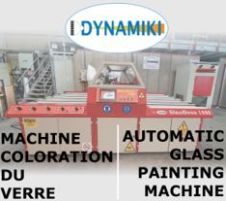Screen printing on flat glass
The screen printing technology comes from the latin word Sericum (soie) and the Greek word graphe (to write). So screen printing means to write on silk.
The first screen printing screen was carried out in Japan with hairs (after came silk, nylon, polyester..).
With screen printing technology you can print on glass a drawing designed on a screen covered with a synthetic material (now generally polyesters) with aroung 40 wires for each centimeter.
The drawing on the screen is done with holes where the drawing has to be printed. The textile is mounted on a frame and the glass positioned under the frame.
The enamel (but it is also possible to use inks, paintings…) is firstly put on the screen and moved after on the glass through the holes with pressure.
The enamel is after fixed on the glass with a heat treatment. This following step is very often done during the glass tempering.
Manufacture screens :
The screen is covered with a photo sensible product which closes every screens holes.
Then the screen is put on the drawing (transparent drawing) which has to be transfered on the screen.
With light action the photo sensible product is destroyed and the holes corresponding to the drawing created.
The screen printing markets :
Décoration : building, internal panels, shower panels…
Appliance : oven doors, vitroceramic cooking plates….
Automotive : wind screen and other glass used on automotive markets
Others : game machines, advertising…









